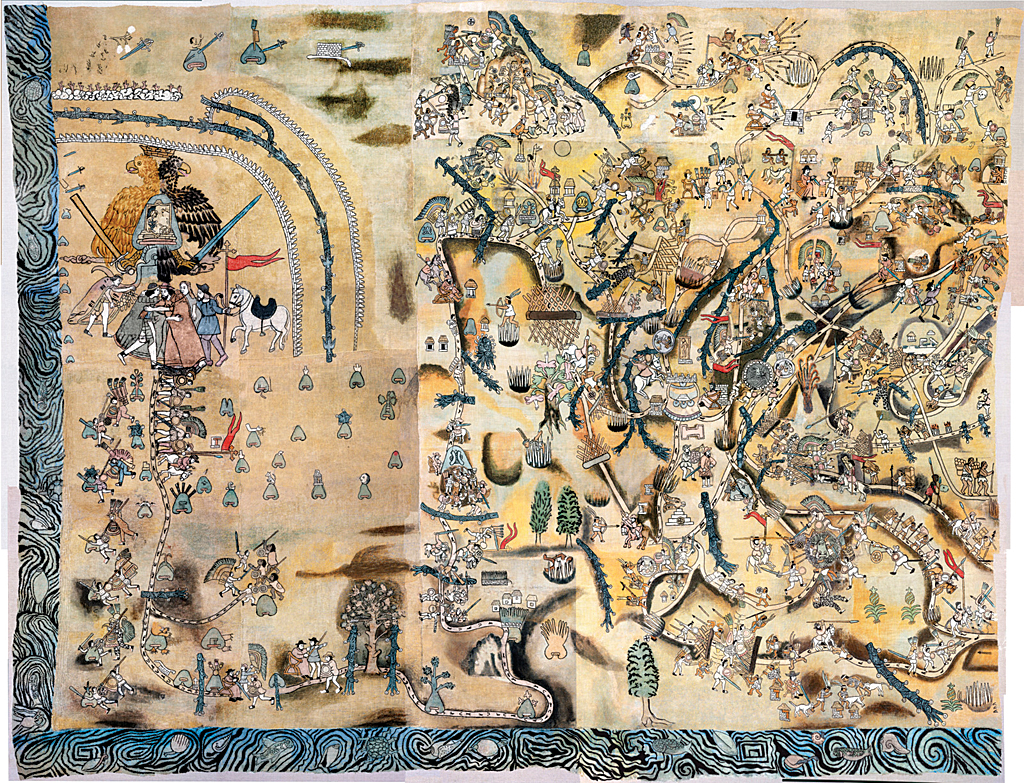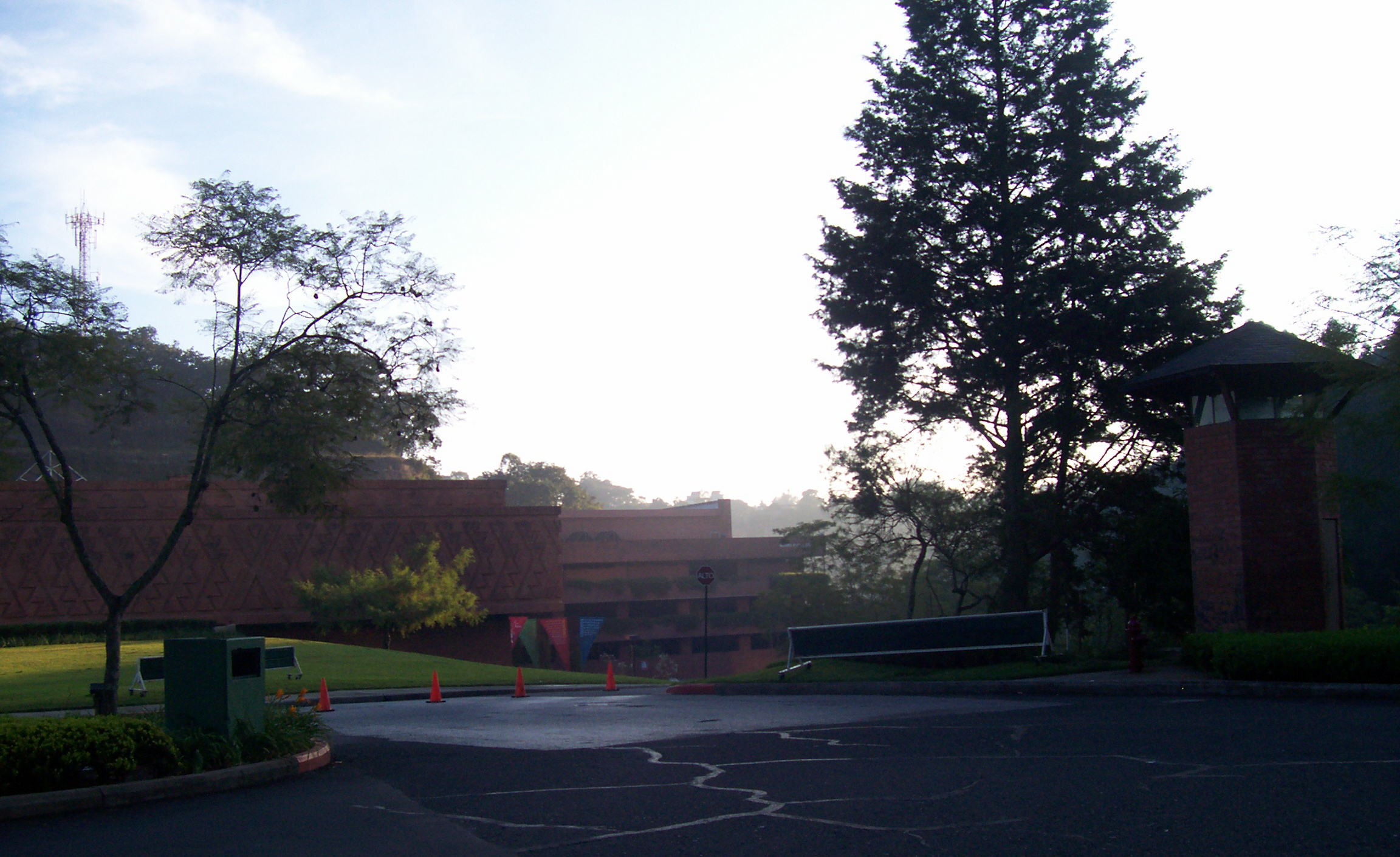|
Lienzo De Quauhquechollan
The Lienzo de Quauhquechollan ("Quauhquechollan Cloth") is a 16th-century '' lienzo'' (cloth painting) of the Nahua, a group of indigenous peoples of Mexico. It is one of two surviving Nahua pictorial records recounting the Spanish conquest of GuatemalaRestall and Asselbergs 2007, p.94. and the earliest surviving maps of what is now Guatemala. The Lienzo was probably painted in Ciudad Vieja, in the modern Guatemalan department of Sacatepéquez, by Nahua allies of the Spanish from the city of Quauhquechollan (now known as San Martín Huaquechula). These allies had assisted conquistador Jorge de Alvarado in his campaign of 1527 to 1529. The Quauhquechollan allies settled in the Guatemalan Highlands and the cloth records their participation in the Spanish conquest of Mexico and Guatemala.Asselbergs 2002, p.1. The original document is currently in the Museo Regional de Cholula, in Puebla in central Mexico.Universidad Francisco Marroquín 2009a. The Lienzo de Quauhquechollan was ... [...More Info...] [...Related Items...] OR: [Wikipedia] [Google] [Baidu] |
Universidad Francisco Marroquín
Francisco Marroquín University (Spanish: ''Universidad Francisco Marroquín''), also known by the abbreviation UFM, is a private, secular university in Guatemala City, Guatemala. It describes its mission as "to teach and disseminate the ethical, legal, and overall economic principles of a society of free and responsible persons." According to Milton Friedman, it is "one of the leading universities in Latin America." History It was founded in 1971 by Manuel F. Ayau, known as Muso. Its namesake is Francisco Marroquín, an early bishop of Guatemala and translator of Central American languages, but the university does not follow any of his teachings or philosophies. Started by members of Center for Economic and Social Studies with $40,000 and 125 students, UFM counted 2700 undergraduate students and 1500 graduate students as of 2009. The philosophy statement says that "universities need to place themselves beyond the conflicts of their time so that science and academic freedom � ... [...More Info...] [...Related Items...] OR: [Wikipedia] [Google] [Baidu] |
Suchitepéquez Department
Suchitepéquez () is one of the 22 departments of Guatemala. Its capital is Mazatenango. It is situated in the southwestern region of Guatemala, bordering Quetzaltenango, Sololá, and Chimaltenango to the north, the Pacific Ocean to the south, Escuintla to the east, and Retalhuleu to the west. Municipalities * Chicacao * Cuyotenango * Mazatenango * Patulul * Pueblo Nuevo * Río Bravo * Samayac * San Antonio Suchitepéquez * San Bernardino * San Francisco Zapotitlán * San Gabriel * San José El Idolo * San Juan Bautista * San Lorenzo, Suchitepéquez * San Miguel Panán * San Pablo Jocopilas * Santa Bárbara * Santo Domingo Suchitepequez * Santo Tomás La Unión * Zunilito Zunilito () is a municipality in the Suchitepéquez department of Guatemala. It is situated at 790 m above sea level Mean sea level (MSL, often shortened to sea level) is an average surface level of one or more among Earth's coastal bodies of w ... References External linksIntera ... [...More Info...] [...Related Items...] OR: [Wikipedia] [Google] [Baidu] |
San Francisco Zapotitlán
San Francisco Zapotitlán () is a town, with a population of 18,468 (2018 census), Population of cities & towns in Guatemala and a in the Suchitepéquez department
Suchitepéquez () is one of the 22 departments of Guatemala. Its capital is Mazatenango.
It is situated in the southwestern region of Guatemala, bordering Quetzaltenango, Sololá, and Chimaltenango to the north, the Pacific Ocean to the sou ... of [...More Info...] [...Related Items...] OR: [Wikipedia] [Google] [Baidu] |
Retalhuleu
The city of Retalhuleu () is situated in south-western Guatemala. It is the departmental seat of Retalhuleu Department Retalhuleu () is a department located in the south-west of Guatemala, extending from the mountains to the Pacific Ocean coast. It has an area of 1856 km2. In 2018 the population of the Department of Retalhuleu was 326,828. Its capital, ... as well as the municipal seat of Retalhuleu Municipality. Retalhuleu stands at about 240 metres above sea level. The city has a population of 90,505 (2018 census). Locally it is nicknamed "Reu." Brief history On August 7 and 8, 2021, Retalhuleu was severely affected by rain, which lasted for 36 hours and caused landslides, floods and other damages to Retalhuleu and other Guatemalan cities. (in Spanish) Sports The local football club is called Juventud Retalteca, who play in the Guatemalan top division. Landmarks Map of Retalhuleu References External links * Municipalities of the Retalhuleu Department< ... [...More Info...] [...Related Items...] OR: [Wikipedia] [Google] [Baidu] |
Chiapas
Chiapas (; Tzotzil and Tzeltal: ''Chyapas'' ), officially the Free and Sovereign State of Chiapas ( es, Estado Libre y Soberano de Chiapas), is one of the states that make up the 32 federal entities of Mexico. It comprises 124 municipalities and its capital and largest city is Tuxtla Gutiérrez. Other important population centers in Chiapas include Ocosingo, Tapachula, San Cristóbal de las Casas, Comitán, and Arriaga. Chiapas is the southernmost state in Mexico, and it borders the states of Oaxaca to the west, Veracruz to the northwest, and Tabasco to the north, and the Petén, Quiché, Huehuetenango, and San Marcos departments of Guatemala to the east and southeast. Chiapas has a significant coastline on the Pacific Ocean to the southwest. In general, Chiapas has a humid, tropical climate. In the northern area bordering Tabasco, near Teapa, rainfall can average more than per year. In the past, natural vegetation in this region was lowland, tall perennial rainforest, but ... [...More Info...] [...Related Items...] OR: [Wikipedia] [Google] [Baidu] |
Soconusco
Soconusco is a region in the southwest corner of the state of Chiapas in Mexico along its border with Guatemala. It is a narrow strip of land wedged between the Sierra Madre de Chiapas mountains and the Pacific Ocean. It is the southernmost part of the Chiapas coast extending south from the Ulapa River to the Suchiate River, distinguished by its history and economic production. Abundant moisture and volcanic soil has always made it rich for agriculture, contributing to the flowering of the Mokaya and Olmec cultures, which were based on Theobroma cacao and rubber of Castilla elastica. In the 19th century, the area was disputed between Mexico and Guatemala until a treaty signed in 1882 fixed the modern border by dividing the area's historical extension, with most going to Mexico and a smaller portion east of the Suchiate to Guatemala. In 1890, Porfirio Díaz and Otto von Bismarck collaborated to take advantage of southern Mexico's agricultural potential by sending 450 German fam ... [...More Info...] [...Related Items...] OR: [Wikipedia] [Google] [Baidu] |
Oaxaca
) , population_note = , population_rank = 10th , timezone1 = CST , utc_offset1 = −6 , timezone1_DST = CDT , utc_offset1_DST = −5 , postal_code_type = Postal code , postal_code = 68–71 , area_code_type = Area code , area_code = , iso_code = MX-OAX , blank_name_sec1 = HDI , blank_info_sec1 = 0.710 Ranked 31st of 32 , blank_name_sec2 = GDP , blank_info_sec2 = US$ 18.18 billion (2020) Ranked 20th of 32 , website = Oaxaca ( , also , , from nci, Huāxyacac ), officially the Free and Sovereign State of Oaxaca ( es, Estado Libre y Soberano de Oaxaca), is one of the 32 states that compose the Federative Entities of Mexico. It is divided into 570 municipalities, of which 418 (almost three quarters) are governed by the system of (customs and traditions) with recognized local ... [...More Info...] [...Related Items...] OR: [Wikipedia] [Google] [Baidu] |
Tehuantepec
Tehuantepec (, in full, Santo Domingo Tehuantepec) is a city and municipality in the southeast of the Mexican state of Oaxaca. It is part of the Tehuantepec District in the west of the Istmo Region. The area was important in pre Hispanic period as part of a trade route that connected Central America with what is now the center of Mexico. Later it became a secondary capital of the Zapotec dominion, before it was conquered by the Spanish in the early 16th century. The city is still the center of Zapotec culture in the Isthmus of Tehuantepec and is the second largest in the region. The city is known for its women and their traditional dress, which was adopted by Frida Kahlo. Tehuantepec has a reputation for being a matriarchal society. Women dominate the local markets and are known to taunt men. However, political power is still the domain of men. The city experienced a short economic boom in the early 20th century related to a rail line that was built linking the two oceans ... [...More Info...] [...Related Items...] OR: [Wikipedia] [Google] [Baidu] |
Hernán Cortés
Hernán Cortés de Monroy y Pizarro Altamirano, 1st Marquess of the Valley of Oaxaca (; ; 1485 – December 2, 1547) was a Spanish '' conquistador'' who led an expedition that caused the fall of the Aztec Empire and brought large portions of what is now mainland Mexico under the rule of the King of Castile in the early 16th century. Cortés was part of the generation of Spanish explorers and conquistadors who began the first phase of the Spanish colonization of the Americas. Born in Medellín, Spain, to a family of lesser nobility, Cortés chose to pursue adventure and riches in the New World. He went to Hispaniola and later to Cuba, where he received an '' encomienda'' (the right to the labor of certain subjects). For a short time, he served as ''alcalde'' (magistrate) of the second Spanish town founded on the island. In 1519, he was elected captain of the third expedition to the mainland, which he partly funded. His enmity with the Governor of Cuba, Diego Velázquez de Cuél ... [...More Info...] [...Related Items...] OR: [Wikipedia] [Google] [Baidu] |
Habsburg Spain
Habsburg Spain is a contemporary historiographical term referring to the huge extent of territories (including modern-day Spain, a piece of south-east France, eventually Portugal, and many other lands outside of the Iberian Peninsula) ruled between the 16th and 18th centuries (1516–1713) by kings from the Spanish branch of the House of Habsburg (also associated with its role in the history of Central and Eastern Europe). Habsburg Spain was a composite monarchy and a personal union. The Habsburg Hispanic Monarchs (chiefly Charles I and Philip II) reached the zenith of their influence and power ruling the Spanish Empire. They controlled territories over the five continents, including the Americas, the East Indies, the Low Countries, Belgium, Luxembourg, and territories now in Italy, France and Germany in Europe, the Portuguese Empire from 1580 to 1640, and various other territories such as small enclaves like Ceuta and Oran in North Africa. This period of Spanish h ... [...More Info...] [...Related Items...] OR: [Wikipedia] [Google] [Baidu] |
Aztec Writing
The Aztec or Nahuatl script is a pre-Columbian writing system that combines ideographic writing with Nahuatl specific phonetic logograms and syllabic signs which was used in central Mexico by the Nahua people. Origin The Aztec writing system derives from writing systems used in Central Mexico, such as Zapotec script. Mixtec writing is also thought to descend from Zapotec. The first Oaxacan inscriptions are thought to encode Zapotec, partially because of numerical suffixes characteristic of the Zapotec languages. Structure and use Aztec was pictographic and ideographic proto-writing, augmented by phonetic rebuses. It also contained syllabic signs and logograms. There was no alphabet, but puns also contributed to recording sounds of the Aztec language. While some scholars have understood the system not to be considered a complete writing system, this is disputed by others. The existence of logograms and syllabic signs is being documented and a phonetic aspect of the writing s ... [...More Info...] [...Related Items...] OR: [Wikipedia] [Google] [Baidu] |




